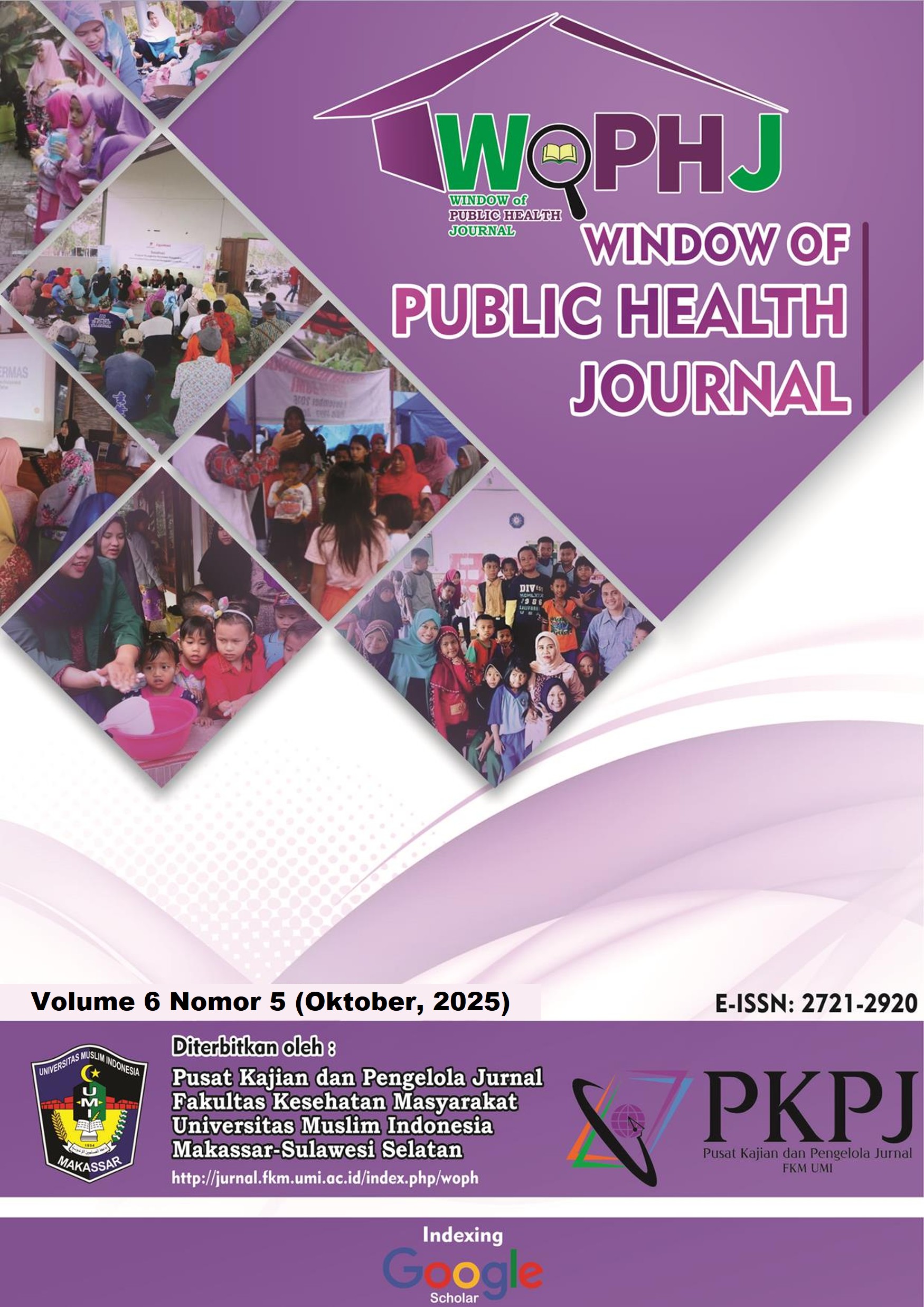Hubungan Pola Pengasuhan Terhadap Kejadian Stunting Pada Balita Umur 6-59 Bulan Di Kelurahan Mangasa
DOI:
https://doi.org/10.33096/qjf1ac49Keywords:
Stunting , Breastfeeding, Toddler, food consumptionAbstract
Stunting, a nutritional issue in toddlers that has not been adequately addressed, is the focus of this study. A person is considered stunted if their Height-for-Age (H/U) Z-score is below -2SD (standard deviation). In accordance with the Sustainable Development Goals (SDGs), it is hoped that by 2030, all types of malnutrition will be overcome, including reducing stunting and wasting rates in toddlers, in line with the global targets set until 2025. The World Health Organization (WHO) estimates that the prevalence of stunting worldwide reached 22% in 2020, affecting approximately 149.2 million toddlers. This study, which employed a quantitative method with a cross-sectional study design, focused on 68 toddlers, of whom 47 were identified as stunted. Data were collected through questionnaires and analyzed using the chi-square test to evaluate the relationship between existing variables. The research findings show that there is no significant relationship between dietary patterns and the incidence of stunting (p = 0.526) in toddlers aged 6-59 months in Mangasa Village, Makassar City. Similarly, there was no relationship between exclusive breastfeeding and the incidence of stunting (p = 0.676) in toddlers of the same age range in Mangasa Village, Makassar City. Likewise, there is no relationship between maternal support in health service practices and the incidence of stunting (p = 0.630) in toddlers aged 6-59 months in Mangasa Village, Makassar City. This study revealed that among dietary patterns, exclusive breastfeeding, and maternal support in health services, there is no significant relationship related to stunting in children aged 6 to 59 months in Mangasa Village. These findings have the potential to shape future policies and interventions. The community is encouraged to continue providing exclusive breastfeeding and maintaining a balanced diet to support maternal and child health, increase family support in child care, and utilize health services such as integrated health posts (posyandu) and community health centers regularly.
References
1. Januarti LF, Yulianto S, Soliha. Hubungan Pola Asuh dan Budaya Pengasuhan terhadap deteksi dini pencegahan stunting pada Balita. JURNAL ILMIAH OBSGIN: Jurnal Ilmiah Ilmu Kebidanan & Kandungan. 2024;16(1):226–36.
2. Putri PS, Lutfiasari D, Lintan N, Kebidanan P, Kesehatan I. Hubungan Antara Pola Asuh Orang Tua Dengan Kejadian Stunting Pada Balita Usia 24-59 Bulan. 2024;2:313–22.
3. Kurniati R, Aisyah S, Anggraini H, Wathan FM, Studi P, Kebidanan S, et al. FAKTOR-FAKTOR YANG MEMPENGARUHI KEJADIAN STUNTING PADA BALITA USIA 24 – 60 BULAN DOI : https://doi.org/10.36729 Jurnal ‘ Aisyiyah Medika PENDAHULUAN Kejadian balita pendek atau biasa disebut dengan s tunting merupakan salah satu masalah gizi yang dialami. Aisyiyah Medika. 2022;7:1–13.
4. Page MT, Damayanti R. Hubungan Pola Asuh Orang Tua Dalam Pemberian Makan Dengan Kejadian Stunting Pada Anak Usia 24-59 Bulan. 2024;8(1):14–20.
5. Di B, Bone K, Enrekang D. Faktor Yang Berhubungan Dengan Kejadian Stunting Pada. 2024;23(1):101–10.
6. Kartikawati SL, Dinata DI, Nurakilah H, Fatmawati F. Edukasi Pendampingan Pola Asuh Keluarga Dalam Upaya Pencegahan Stunting Pada Balita Family Parenting Assistance EducationIn Efforts to Prevent Stunting in Toddlers. 2023;8(2):328–37.
7. Arda. Bunga dkk. Program studi pendidikan profesi ners fakultas ilmu kesehatan universitas respati yogyakarta 2020. Atresia Ani Pada Anak. 2020;15(2):40.
8. Abd Arafat, Rosita R, Rabia R, Siti S. Hubungan Pengetahuan dan Pola Makan dengan Kejadian Stunting pada Balita di Wilayah Kerja Puskesmas Sangurara Kota Palu. Jurnal Kolaboratif Sains. 2022;5(9):618–26.
9. Novayanti M, Thirayo YS. Buletin Kesehatan MAHASISWA Hubungan Pemberian Asi Esklusif dengan Kejadian Stunting pada ( The Relationship between Exclusive Breastfeeding with Stunting Incidence in Toddlers in the Working Area of the Toili I Puskesmas ). Buletin Kesehatan MAHASISWA. 2023;02(1):1–9.
10. Anggraini SD, Lestari D, Palupi M, Widiastuti A. HUBUNGAN POLA ASUH ORANG TUA TERHADAP KEJADIAN STUNTING PADA ANAK BALITA USIA 1-5 TAHUN DI WILAYAH. 2024;5(September):6706–12.
11. Hidayat AN, Kesehatan FI. Hubungan Pola Asuh Ibu Dengan Kejadian Stunting Pada Anak Usia 24 -60 Bulan di Kelurahan Teritih Wilayah Kerja Puskesmas Kalodran Kota Serang Provinsi Banten Tahun 2022. 2023;1(2).
12. Ni Made Puspita Ningrum, Made Rismawan, Ni Kadek Sriasih. Hubungan Antara Pola Makan Dengan Kejadian Stunting Pada Anak Usia 6-24 Bulan Di Wilayah Kerja Puskesmas I Denpasar Barat. Jurnal Mutiara Kesehatan Masyarakat. 2024;9(2):78–87.
13. No V, Juli E, Ekslusif ASI, Asupan DAN, Kejadian D, Pada S, et al. 1213-9965-1-Pb. 2022;4(4):372–82.
14. Novayanti LH, Armini NW, Mauliku J. Hubungan Pemberian ASI Eksklusif dengan Kejadian Stunting pada Balita Umur 12-59 Bulan di Puskesmas Banjar I Tahun 2021. Jurnal Ilmiah Kebidanan (The Journal Of Midwifery). 2021;9(2):132–9.
15. Sari K, Ayu R, Sartika D. The Effect of the Physical Factors of Parents and Children on Stunting at Birth Among Newborns in Indonesia. 2025;309–16.
16. SINDRI S, HANDAYANI TS, SARI LY. Hubungan Dukungan Keluarga Dengan Perilaku Ibu Dalam Memenuhi Nutrisi Balita Di Wilayah Kerja Puskesmas Sp Iii, Pumu Lahat Tahun 2023. Journal Of Midwifery. 2024;12(1):40–8.
Downloads
Published
Issue
Section
License
Copyright (c) 2025 Husnul Khaeriyah Sogalrey, Nurul Ulfah Mutthalib, Mansur Sididi

This work is licensed under a Creative Commons Attribution-NonCommercial-ShareAlike 4.0 International License.







